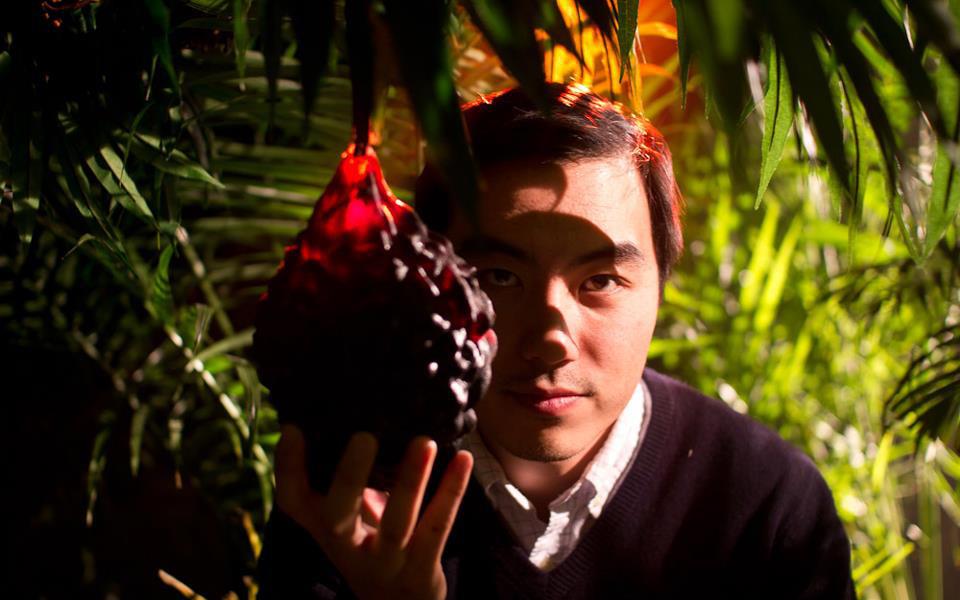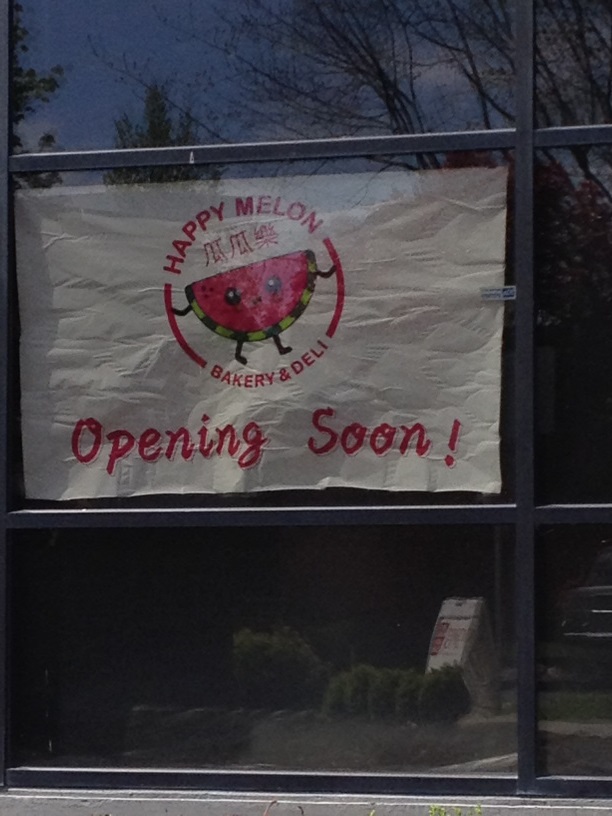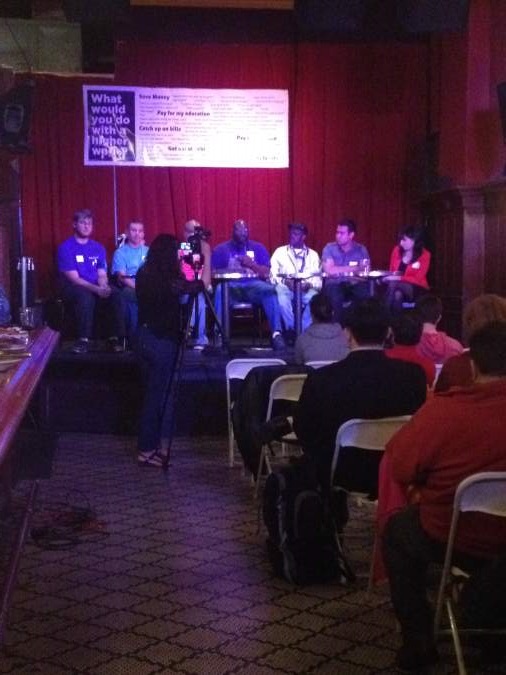Nakji bokkeum, the classic Korean octopus dish that’s a stated specialty of Shoreline’s SanMaRu Grill, is typically roughed up with a jab/cross/hook of chili-based heat. Most preparations call for pan-frying the chewy tentacle segments with red chili-pepper paste, red chili-pepper flakes, and fresh red chili peppers, which collude to make your nostrils quiver. But the forlorn nakji bokkeum with noodles on our table was a weak shadow of what the menu promised: Its crimson sauce was so intensely sugared that the dish tasted eerily like what Olive Garden would serve in never-ending portions.”I don’t know what’s in it,” our server confessed when we asked him whether the chef had unconventionally added tomatoes to the stir-fry. “I told him not to make it spicy.”When we protested that we’d ordered the nakji bokkeum precisely because it was spicy, he demurred, “Americans don’t like it.” Only after he’d extracted a guarantee that we wouldn’t hold him responsible if we saw stars and sweated through our socks did he consent to ask the chef to remake what was left of our dish. He returned minutes later with the thickly sauced noodles, shrunken from another run through the frying pan, tweaked to “three-star heat.” According to our server, that’s the default setting for Korean customers. (Although neither the menu nor the server initially alluded to a spice scale, receipts showed that every dish served to us palefaces featured one-star heat.)The revised dish was spicier, but still a far cry from spicy: My grandmother, who made a mean chicken croquette, would have called it “highly seasoned.” The modest addition of red chili-pepper paste, the gochujang that’s crucial to Korean cookery, blotted out the strange Italian-American flavors that clung to the first onion-laden serving, but its influence ended there. We asked whether we might upgrade to five-star heat, a request that clearly unsettled our server: He delivered the now-microscopic dish along with a pitcher of ice water and three blue plastic glasses. The chilis were finally vivid, and pleasantly so.The nakji bokkeum incident wasn’t the first evidence of SanMaRu’s bowdlerizing instincts. I’d previously popped into the restaurant, which recently underwent its second ownership change in three years, for a warming bowl of sundubu, the traditional fresh tofu stew that’s invariably described as spicy. The dish had the washed-out cast of a 1970s family portrait, its broth pumpkin-pie orange instead of the usual peppery red. At its best, spice is a full-body experience, but this sundubu’s tingle stopped on my lips. I felt like I’d stood in line for the Corkscrew and boarded a carousel. Frustrated, I asked for hot sauce. The server brought me a saucer of gochujang and a pinch of gochugaru, a Korean chili-pepper powder which he advised I use sparingly. Once doctored, the stew was excellent.I was referred to SanMaRu by a native Korean who I suspect has had very different experiences there, a suspicion strengthened every time I watched servers bring purple rice to Korean customers before bringing white rice to me. Although I caught glimpses of the kitchen’s potential in tamer dishes, such as a delicately grilled mackerel and a nicely crusted bibimbap, nothing I sampled explained why the restaurant hung a movie poster–style sign showcasing chef Jong Onk Yoon’s face and resume (Yoon cooked at Hosoonyi and Seoul Hot Pot before arriving at SanMaRu, which was formerly Kaya). While eaters around me thrilled to seafood hot pots and cod-roe soups flush with flavor, I was stuck with food purged of its personality.The situation at SanMaRu is far from unique. Eaters who ramble beyond their heirloom cuisines are accustomed to having to work harder for their meals in immigrant-run restaurants, regardless of their skin color (when pressed, the SanMaRu server admitted he would have insisted upon the same underspicing for a table of African-American diners as he had for one occupied by Caucasians). They can’t read untranslatable specials signs or replicate feasts on nearby tables without pointing and pleading. For Eddie Huang, the Taiwanese-American New York City restaurateur who’s forever thinking about cultural crossings, overcoming the objections of skeptical servers is what makes culinary exploration fun. “Restaurants have lost a lot of the allure for me since the advent of Yelp and all these online sites and apps,” he says. “Discovering dishes, techniques, spices, and communities used to be a lot more personal and organic.”But should diners always be forced to play the game? Is it really the chef’s prerogative to withhold dishes and drastically adjust seasonings, much as he might refuse to substitute gluten-free pasta for handmade tagliatelle? Or do restaurants have an obligation to serve what’s listed on their menus, despite fears it will alienate American-born guests and hurt business?”Customers complain,” our SanMaRu server told us repeatedly when we asked why ordering raw beef, pork-feet salad, and a spate of spicy dishes didn’t adequately establish our interest in uncensored Korean cuisine.It’s hard for me to imagine a skittish eater wandering into a restaurant patronized primarily by Korean speakers, ordering a dish labeled “spicy,” and then complaining about it being too hot. The nervous eaters I know aren’t liable to experiment with exotic cuisines in the first place, and they don’t order a new dish without making doubly sure it’s mild. So just who are these bravado-afflicted diners ruining restaurants for the rest of us?Heongsoon Park—chef/owner of Chan, a Pike Place restaurant which explicitly aims to make Korean dishes more accessible by downplaying funk and balancing spice with sweetness—doesn’t blame the complainers. While Americans have grown increasingly comfortable with heat, inspiring a wave of spicy fast-food sandwiches slathered with ghost-pepper sauce and jalapenos, Park says the tangy, vinegar-based spice familiar from buffalo wings doesn’t prepare eaters for Korean-style spicing.It’s also possible that when diners complain about dishes being too hot, spice isn’t the problem: They just don’t have the vocabulary to indicate what’s really bothering them. “I have family and friends who own ethnic restaurants, and they’ve had so many bad experiences with Americans, i.e., white people, sending food back,” Huang says. “It’s not just about spicy. It could be texture, it could be aromatics, it could be meat on the bone that shows marrow.”Park says Korean restaurant owners are especially sensitive to causing discomfort. “We’re always trying to make adjustments,” he says, attributing the impulse to the country’s long history of poverty. “We’ve been at the bottom once, and we want to get out of there.”Pulitzer Prize–winning food critic Jonathan Gold, among the first food writers to chronicle first-generation Asian restaurants for an American-born audience, agrees the phenomenon of “deracinated dishes” is especially pronounced in Korean restaurants. “Koreans tend to have an inferiority complex about their food that is weirdly extreme,” he says. “They think non-Koreans like barbecue, period. I can’t tell you how many times in the ’80s and ’90s I went to restaurants in L.A.’s Koreatown specializing in things like blood sausage, grilled beef intestines, or black goat stew, only to be offered a choice of galbi or bulgogi.”Gold gets around the problem by showing up at restaurants until servers relent. “They either get used to me or give me the real stuff to get rid of me,” he says.But he’s also made peace with Korean restaurant owners’ reluctance to challenge American palates. “The problem is that it comes out of hospitality—the desire to give you what they really think you’d like,” he says. “It took me a while to figure that one out.”When diners stray beyond their native cuisines, they attribute their adventures to curiosity. They want to understand people halfway around the world by learning how and what they eat. But sometimes the real lesson lies in the dishes they can’t get.If an American eater says he’s a sophisticated food lover, he expects to be served the fertilized duck embryos he’s craving. Anything less strikes him as an unforgivable breach of contract. But Koreans have a different perspective: They hail from a country where until recently “ethnic homogeneity” was a national point of pride. They’re culturally disinclined to interpret food preferences on an individual basis. Many Korean restaurant owners firmly believe all Americans don’t like spice and funk, so they try to protect us from it. That authentic kindness reveals more about the Korean people than a pound of gochujang. hraskin@seattleweekly.comPRICE GUIDEBibimbap $11.99Fish roe soup $13.99Nakji bokkeum $17.99
Nakji bokkeum, the classic Korean octopus dish that’s a stated specialty of








